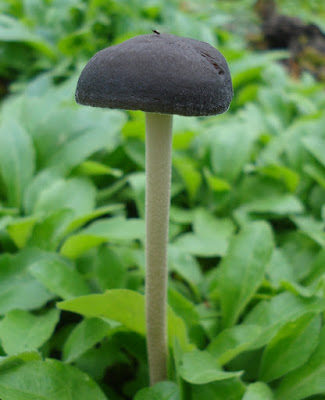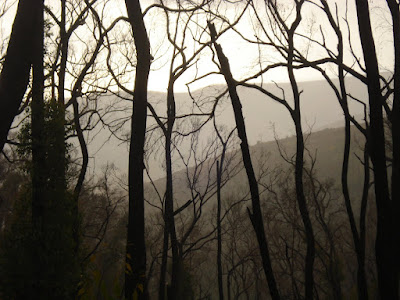I woke up early this morning, and decided I'd take the train back to the Dandenongs. It's been raining quite a bit there recently, and the humidity has stayed above 90%, and best of all I was going alone, so no one could complain about me spending half an hour walking 100m.
I came across these even before entering the park. They're growing on a massive tree stump outside puffing billy (that wonderful celebration of locally polluting transportation), and they were there for my first visit to the Dandenongs, two years ago with Michael Livingstone. I had no idea what they were. I'm now more sure that they're the honey fungus,
Armillaria luteobubalina (which sounds awesome). They're an agressive parasite, and although they love dead wood, they're not afraid to venture to neighbouring plants, as you can see below:
This was weird. Next to an old clapped out Datsun 180, a license plate graveyard.
Now these are some sort of
Panaeolus spp., I'd wager. Very conical, dark spored, but on second thoughts, the cap seems too transparent, and the stem too insubstantial.
I wish I knew, and I wish I'd managed better pictures. The caps in particular were really viscid, and clearly marked with black spots, like this:
A small
Hypholoma spp.The truly majestic mountain breed of
Psilocybe subaeruginosa. They always tower above the surrounding grass and undergrowth.
Mycena spp., in front of some orange bracket fungi.
This species has me stumped.
Lycoperdon pyriforme, a puffball.
Clitocybe clitocyboides, standing between me and a questing leech.
Lycoperdon pyriformeThis is a close-up of its apical pore.
Geastrum triplexNot sure. Must find out.
Ah, these beauties are
Dermocybe austrovenetas. As you can see, they have a greeny colour that's quite unusual for mushrooms, particularly ones so large. On the whole, mushrooms steer clear of the shade, which they disparagingly leave to the "seeders".
But, speaking of green, I was very pleased with this find. These are
Chlorociboria aeruginascens, an Ascomycota species that was used in the past to stain wood to make coloured Tunbridge Ware inlay. You can't see it so well in this photo, but the wood was stained so green I temporarily thought the council had sprayed it with their toxic copper compounds. Then I looked around me, realised I was 250m off the path in the middle of a fern gully in the Dandenongs, with no other green staining around me, and decided that was unlikely.
Two
P. subaeruginosa individuals, showing their hygrophanous caps (i.e., they change colour as they dry).
Their close relative,
Stropharia aurantiaca, or the red emperor























































